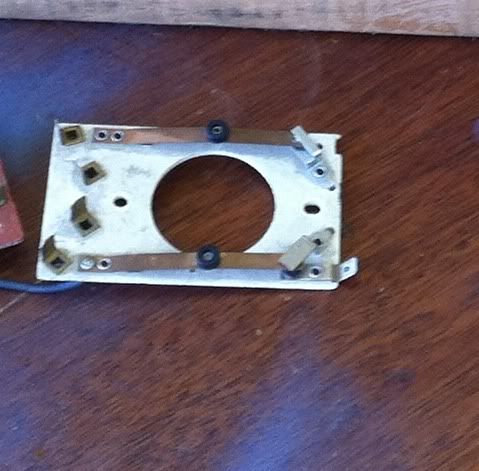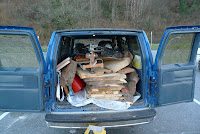My recent flurry of plane tuning while convalescing continued onto a couple other planes, a spokeshave that belonged to my grandfather, and some Japanese chisels. With all these great functional tools now lying around, it was inevitable that progress would be made on a project.
Grampa's Spokeshave Rehabilitated
So I whipped up a simple wall shelf out of cherry and catalpa. All the wood in it I milled up previously with my Alaska mill. The cherry about six years ago, the catalpa two or three. The back panel is a single piece of catalpa that is 13” tall and 23” wide. It was a leftover piece from a slab about 5’ long that I had cut to length for another project.
A friend resawed the catalpa on his 20” Crescent bandsaw with a Laguna blade. It was unbelievable, smooth enough to use without any sanding. My Minimax was choking on it, I need to do some work on the chip clearance. Wall hangers I made up myself from brass. The back is attached with loose screws and enough space to allow for seasonal movement.
Resawing Catalpa on Crescent Bandsaw
One bad oops occurred when I drilled some holes in the catalpa in the wrong spot. They were for screws and supposed to line up with the backs of the shelves but did not! Luckily I had the foresight to cut up a couple spare back pieces when I was over at my friend's place.
The cherry was all planed, or for the ornery bits, scraped. I then rubbed it with the shavings and ran some steel wool over it. Edges were softened with a block plane and a strip of 600 grit sandpaper. Finish is a couple coats of padded on shellac with beeswax on top.
Now I can put my Hammond Glider accessories on the shelf and they will be “away”, I no longer have to constantly move them around my shop to get them “out of the way”!
Meanwhile, I had a bunch of burls lying around that got the better of me and I wound up slicing them all up, in the hopes that they would dry faster / more evenly in smaller pieces. Maple and walnut. Don't have much experience with burl so this is a bit of an experiment.
Spalted Maple Burl
I also scored three small firewood sized logs of holly from the yard of a demolished house in the neighbourhood. I have had trouble getting holly to stay white while it dries, so I sliced these up on the bandsaw right away and threw them in the kiln at full blast. I had hoped that this would prevent blue stain, but it did not seem to yield any real improvement.
Looks like my three dead 2100 chainsaws are going to come back from the dead, three new pistons and two replated cylinders later. If all of these come together I will own 8 high powered chainsaws. Three or four will be out the door in short order to help recoup some costs.
I also milled up another yellow cedar chunk down at the beach. Brutal embedded sand in the cracks. Went for 3+" thick slabs. Then I could not move them to my van so I wound up splitting them along the crack. The chainsawing area is now closed till the fall. Seems my rib has healed up enough to get back to the milling, just in time for the milling area to close until the fall. Sigh.


















































